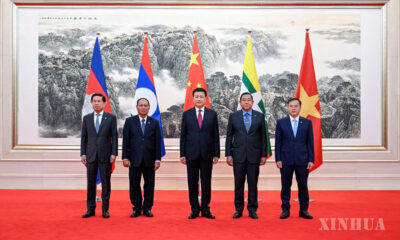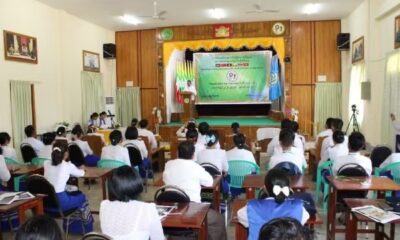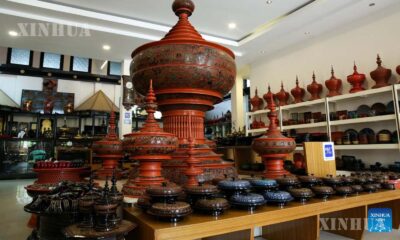Social
လန်ချန်း-မဲခေါင် ဆိုလာဓာတ်အားပေးရေးစီမံကိန်းက မြန်မာနိုင်ငံရှိ ဝေးလံခေါင်သီသောကျေးရွာရှိ လူမှုဘဝများကို အားဖြည့်ပေး

ရန်ကုန်၊ ဩဂုတ် ၁၃ ရက် (ဆင်ဟွာ)
မြန်မာနိုင်ငံ ဧရာဝတီတိုင်းဒေသကြီး ဒေးဒရဲမြို့နယ်ရှိ ဝေးလံခေါင်သီလှသော ကျေးရွာလေး ဖြစ်သည့် ကံဆိပ်ကျေးရွာ၏ တစ်ချိန်တစ်ခါက ညအချိန်များမှာ မှောင်မိုက်အတိပင်ဖြစ်သည်။ ကျေးလက်နေမိသားစုများက ထမင်းဟင်းချက်ပြုတ်ရာတွင် ထင်းမီးဖိုများအသုံးပြုရသလို နေဝင်ပြီးနောက် အခြေခံလုပ်ငန်းများလုပ်ဆောင်ရန် မီးအိမ်များကို အမှီပြုအသုံးပြုရခြင်း ဖြစ်သည်။
ကံဆိပ်ကျေးရွာသားများ၏ အလှမ်းဝေးလှသော အိပ်မက်တစ်ခုမှာ အချိန်မရွေး လျှပ်စစ်မီးရရှိရေးပင် ဖြစ်သည်။ယခုမူကား လန်ချန်း-မဲခေါင်ပူးပေါင်းဆောင်ရွက်မှု (LMC) အထူးရန်ပုံငွေ ပံ့ပိုးမှုဖြင့် ဆိုလာအသေးစားဓာတ်အားပေးစနစ်နှင့် ရေပေးဝေရေးလုပ်ငန်းစီမံကိန်းကြောင့် ကံဆိပ်ကျေးရွာရှိ အိမ်ခြေ ၁၅၀ ခန့်မှာ လျှပ်စစ်မီးနှင့် သန့်ရှင်းသောရေများ ရရှိနေကြပြီဖြစ်သည်။
၂၀၂၄-၂၀၂၅ ဘဏ္ဍာနှစ်အထိ ဧရာဝတီတိုင်းဒေသကြီးရှိ ကျေးရွာ ၁၁,၈၆၀ ရွာအနက် ၂,၉၈၄ ရွာမှာ လျှပ်စစ်မီးရရှိနေပြီဖြစ်သည်။ ကျေးရွာ ၂,၉၂၇ ရွာမှာ အမျိုးသားလျှပ်စစ်ဓာတ်အားလိုင်းကွန်ရက်နှင့် ချိတ်ဆက်ထားပြီး ၅၇ ရွာမှာ ဓာတ်အားလိုင်းကွန်ရက်ခွဲစနစ်များဖြစ် ဆောင်ရွက်ပေးလျက်ရှိသည်။
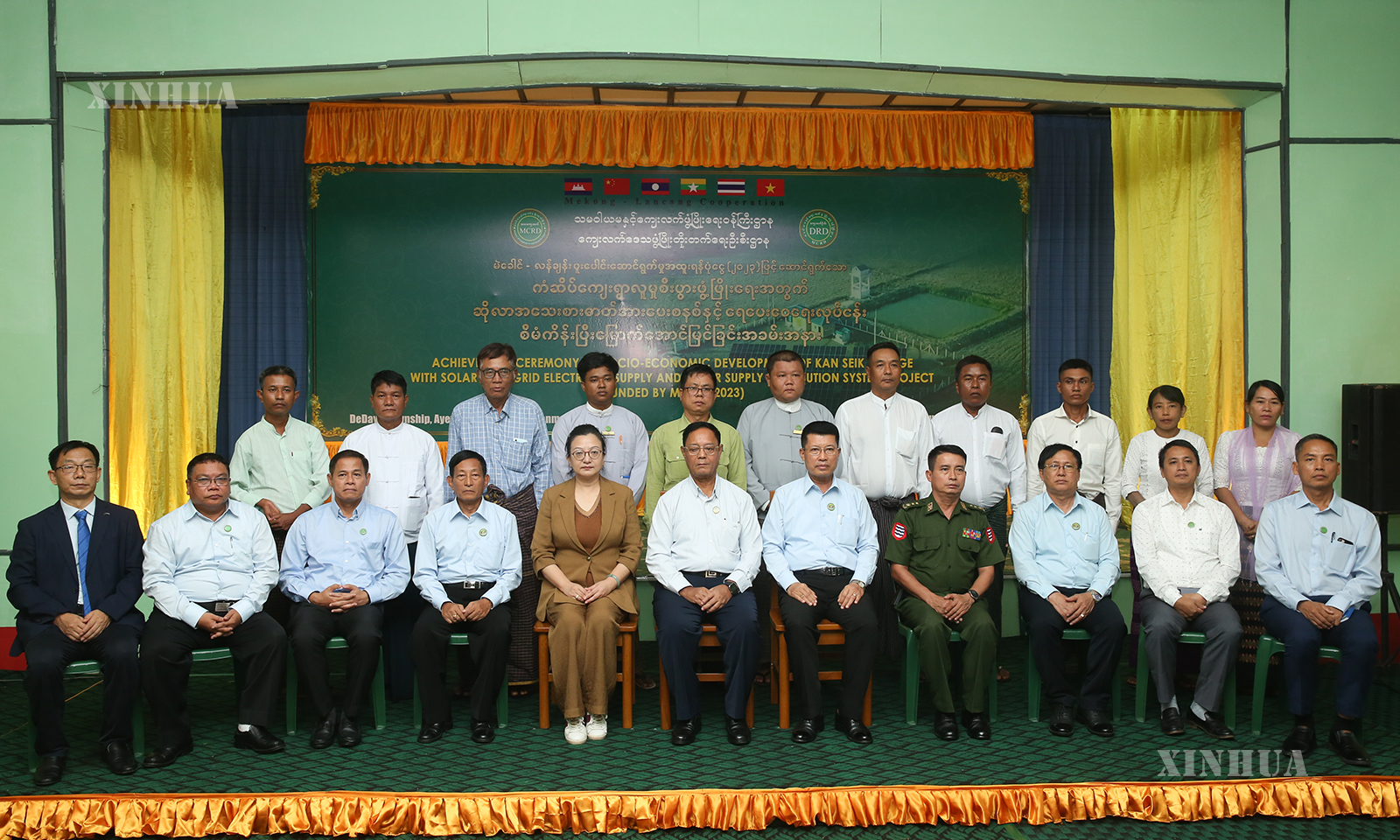
ကံဆိပ်ကျေးရွာရှိ အိမ်ထောင်စုများအတွက်မူ နေ့စဉ်လူမှုဘဝမှာ ရုန်းကန်မှုနှင့် အသားကျနေပြီဖြစ်သည်။ ထင်းများကို စုဆောင်း၊ ဝယ်ယူရသလို ရေနံဆီမီးအိမ်များနှင့် ဘက်ထရီများကိုလည်း မကြာခဏ လဲလှယ်ရကာ ကလေးငယ်များမှာ မီးရောင်မှိန်မှိန်အောက်တွင် စာကျက်မှတ်လေ့လာကြရသည်။
“အဲဒါတွေက အချိန်ရော ကြိုးစားလုပ်ကိုင်ရတာတွေရော အများကြီးလုပ်ရပါတယ်။ ကျွန်မတို့ ပင်ပန်းကြရတယ်” ဟု အသက် ၄၃ နှစ်အရွယ် ဒေါ်စန်းစန်းရင်က ဆိုသည်။ ကံဆိပ်ကျေးရွာတွင် ဆိုလာအသေးစားဓာတ်အားပေးစနစ်နှင့် ရေပေးဝေရေးလုပ်ငန်းစီမံကိန်း အောင်မြင်ပြီးမြောက်ခြင်းက အရာအားလုံးကို ပြောင်းလဲပေးလိုက်သည်။
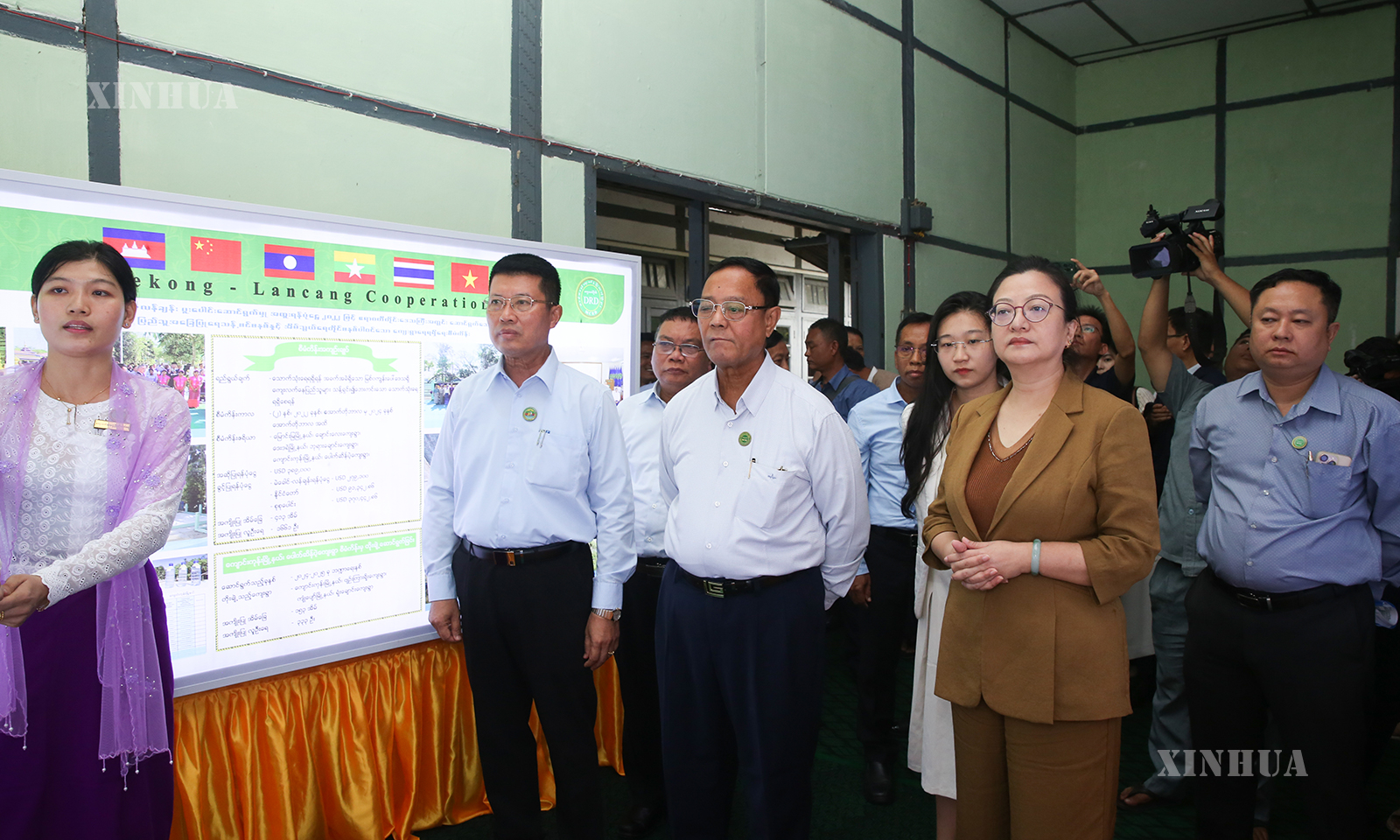
လျှပ်စစ်မီး အချိန်ပြည့်ရရှိခြင်းနှင့်အတူ ဒေသခံရွာသူရွာသားများသည် ထင်းမီးများနေရာတွင် လျှပ်စစ်မီးဖိုများနှင့် မုန့်ဖိုများကို အစားထိုးအသုံးပြုလာကြပြီဖြစ်သည်။ ယခုအခါ အစားအစာများကို ရေခဲသေတ္တာများတွင်လည်း သိုလှောင်သိမ်းဆည်းနိုင်ပြီဖြစ်သည်။
ထို့ပြင် ဂဟေဆော်သည့်လုပ်ငန်းများနှင့် ရေခဲမုန့်ထုတ်လုပ်သည့် လုပ်ငန်းများ စသည့် အသေးစား စီးပွားရေးလုပ်ငန်းများအနေဖြင့်လည်း မီးစက်မလိုတော့ဘဲ လုပ်ငန်းလည်ပတ်လာနိုင်သလို ဒေသခံအလုပ်အကိုင်များကို ဖန်တီးပေးနိုင်ပြီ ဖြစ်သည်။
ဈေးဆိုင်များမှာလည်း အလားတူပင် ခေတ်နှင့် လျော်ညီလာပြီဖြစ်သည်။ ကျေးရွာစာသင်ကျောင်းအနီး စတိုးဆိုင်ဖွင့်ထားသူ အသက် ၅၈ နှစ်အရွယ် ဦးကျော်လင်းက ရေခဲကို အခြားမြို့များမှ ဝယ်ယူရလေ့ရှိသူဖြစ်သည်။ “အခုဆိုရင်တော့ ကျွန်တော်တို့မှာ ကိုယ်ပိုင် ရေခဲသေတ္တာရှိပြီလေ။ ရေခဲထုပ်တွေကို ကိုယ်တိုင်သိမ်းဆည်းနိုင်သလို ပြန်ရောင်းလို့လည်း ရနေပြီ” ဟု ပြောပြခဲ့သည်။
ညဘက်အချိန်လည်း လမ်းမီးတိုင်များ၏ အလင်းရောက်အောက်တွင် ဘေးကင်းကင်းဖြင့် လမ်းလျှောက်သွားလာနိုင်ပြီဖြစ်သည်။ ထိန်လင်းသော မီးအလင်းရောင်အောက်ဝယ် ကျောင်းသား၊ ကျောင်းသူများ ပညာလေ့လာနိုင်သလို လူငယ်များအနေဖြင့်လည်း စွမ်းရည်အသစ်များ လေ့လာဆည်းပူးနိုင်ရန် အင်တာနက်အသုံးပြုနိုင်ပြီဖြစ်ကြောင်း ၎င်းက ထပ်လောင်းပြောကြားခဲ့သည်။
ဧရာဝတီတိုင်းဒေသကြီး ဝန်ကြီးချုပ် ဦးတင်မောင်ဝင်းက ဤစီမံကိန်းသည် ဒေသခံတောင်သူလယ်သမား ၇၅၀ ဦးအား အချိန်ပြည့် လျှပ်စစ်မီးနှင့် ရေရရှိရေးကို ဖြေရှင်းပေးနိုင်ခဲ့ကာ ဒေသတွင်းစီးပွားရေး အားကောင်းရန် အထောက်အကူပြုပေးလျက်ရှိသလို ကျေးရွာ၏ ရေရှည်စီးပွားရေးဖွံ့ဖြိုးတိုးတက်မှုကိုလည်း အားပေးမြှင့်တင်ပေးနိုင်ခဲ့ကြောင်း ပြောကြားခဲ့သည်။
လျှပ်စစ်မီးရရှိခြင်းသည် ပညာရေးနှင့် ကျန်းမာရေးစောင့်ရှောက်မှု ရရှိရေးကို ကြီးမားစွာ မြှင့်တင်ပေးလျက်ရှိပြီး ရေပေးဝေရေးစနစ်သစ်ကလည်း ရေကြောင့်ဖြစ်ပွားသော ရောဂါများအား ကာကွယ်ရာ၌ အထောက်အကူပြုပေးနိုင်ကာ ရပ်ရွာလူထုအတွက် ပိုမိုကောင်းမွန်သော ပြည်သူ့ကျန်းမာရေးရလဒ်များ မြှင့်တင်ပေးနိုင်ကြောင်း ၎င်းက ထပ်လောင်းပြောခဲ့သည်။
ထို့ပြင် သမဝါယမနှင့် ကျေးလက်ဖွံ့ဖြိုးရေးဝန်ကြီး ဦးလှမိုးကလည်း တရုတ်နိုင်ငံ အစိုးရ၏ စိတ်ရင်းစေတနာကြီးမားသော ပံ့ပိုးကူညီမှုအား လွန်စွာကျေးဇူးတင်ရှိကြောင်း၊ ယခုလို ကူညီပံ့ပိုးမှုက ကျေးရွာ၏ လူမှု-စီးပွားဖွံ့ဖြိုးတိုးတက်မှုကို စီမံကိန်းအားဖြင့် မြှင့်တင်ပေးနိုင်ခဲ့ကြောင်း ပြောကြားခဲ့သည်။
“ကျေးလက်ဖွံ့ဖြိုးတိုးတက်ရေးအဆင့်မြင့်စီမံကိန်းတွေမှာ မိတ်ဖက်ဆောင်ရွက်မှုတွေ ဆက်လက်လုပ်ဆောင်သွားနိုင်ဖို့လည်း မျှော်လင့်ပါတယ်” ဟု ၎င်းက ထည့်သွင်းပြောကြားခဲ့သည်။ (Xinhua)
#LMC #SpecialFund #SolarPowerProject #KanSeikVillage #လန်ချန်း_မဲခေါင်ပူးပေါင်းဆောင်ရွက်မှု #အထူးရန်ပုံငွေ #ဆိုလာအသေးစားဓာတ်အားပေးစနစ် #ကံဆိပ်ကျေးရွာ
……………………………………..
(English Version)
Feature: LMC-funded solar power project brightens lives in Myanmar’s remote village
YANGON, Aug. 11 (Xinhua) — In Kan Seik, a remote village in Myanmar’s Dedaye township in Ayeyarwady region, nights were once completely dark. Families cooked over firewood stoves and relied on flashlights for basic tasks after sunset.
For villagers, the idea of having electricity around the clock felt like a distant dream.
Now, thanks to a solar mini-grid and a reliable water supply system, funded by Lancang-Mekong Cooperation (LMC) Special Fund, about 150 homes in Kan Seik village are enjoying steady electricity and clean running water.
“Before the solar mini-grid system was completed, we used firewood for cooking. Now, we can use electric cookers. This saves time spent searching for firewood and is also good for the environment,” said U Kyi Lin, a member of the Kan Seik Village Electrification Committee.
“If we wanted to watch TV, we had to start a generator. Even going to the toilet at night meant using a torchlight. Without electricity, it felt like we were blind,” he added.
Located far from the nearest town and close to the Andaman Sea, Kan Seik was one of the last places anyone expected to see electrification. According to U Kyi Lin, many nearby villages, even those closer to towns, still live without power.
“Now, we have 24-hour electricity. We’re always thankful to the governments of Myanmar and China, the countries of the Lancang-Mekong Cooperation, and all the stakeholders who made this possible,” he said.
“Even in towns and cities, the power sometimes goes out. But here, we get electricity all day and night,” U Kyi Lin said on Sunday during the ceremony to mark the completion of the project.
As of the 2024-2025 fiscal year, only 2,984 of 11,860 villages in the Ayeyarwady region have access to electricity. This included 2,927 villages connected to the national grid and 57 served by mini-grid systems.
For the families in Kan Seik, daily life used to be a struggle. Firewood had to be gathered or bought, oil lamps and batteries frequently replaced, and children studied under dim light.
“It took so much time and effort. We were tired,” said Daw San San Yin, a 43-year-old resident.
Everything changed with the completion of the Kan Seik Village Solar Mini-grid Electricity Supply and Water Supply Distribution System Project.
With constant electricity, villagers have replaced firewood with electric stoves and ovens. Food can now be stored in refrigerators.
Small businesses like welding shops and ice-making units are operating without generators, creating local jobs.
Shops have modernized too. Ko Kyaw Lin, 58, who runs a store near the village school, used to bring in ice from other towns. “Now, we have our own refrigerator,” he said. “We can store and sell ice packs ourselves.”
Streetlights have made it safer to walk at night. Students can study under bright lights, and young people are using the internet to learn new skills, he added.
Ayeyarwady Region Chief Minister Tin Maung Win said the project, which provides round-the-clock electricity to about 750 residents, is helping strengthen local businesses, contributing to the village’s long-term development.
He added that having electricity has greatly improved access to education and healthcare, and the new water system would help prevent waterborne diseases, promoting better public health outcomes for the community.
Union Minister for Cooperatives and Rural Development U Hla Moe also expressed his deep gratitude to the Chinese government for its generous support, saying that their contribution made the socio-economic development of the village with the project possible.
“We sincerely hope for continued partnership in advancing rural development initiatives,” he added.

